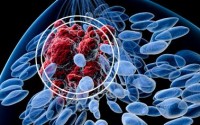The chemistry of anti-cancer drugs
- Date
- 17 Mar 2015
- Start time
- 7:30 PM
- Venue
- Tempest Anderson Hall
- Speaker
- Patrick McGowan

The chemistry of anti-cancer drugs
Patrick McGowan, Reader in the School of Chemistry, University of Leeds
Molecules containing metals have been used in cancer treatments for some years. Metal-based drugs are known for their potent cytotoxic activity and clinical efficacy. Cis-platin exemplifies the fact that metal-containing drugs can be effective anticancer drugs but their activity is compromised by the emergence of resistance and toxicity to normal tissues. The discovery of cis-platin was serendipitous and current work explores the path to rational design of potent anticancer drugs.
Member’s report
Anti-cancer drugs are generally toxic: to be effective against cancer, they must be more toxic to cancerous cells than to normal ones. Until recently, most were discovered by chance. Nitrogen mustards, related to mustard gas, have been used in chemotherapy, but proved to be generally too dangerous. Naturally-occurring substances such as taxol, produced by yew trees, are effective against some cancers, but are difficult to extract. Large amounts of yew are needed to obtain useful amounts of taxol, and it has proved difficult to synthesise artificially.
Many of the early chemotherapeutic compounds were used with very little understanding of how they worked. Paddy McGowan explained how understanding the mode of action of anti-cancer substances work leads to the synthesis of novel chemical compounds with potent anti-cancer effects.
One example: it was noticed (by accident) that the metal platinum had effects on the growth of cells in a culture vessel. The effects turned out to be due to formation of an odd little organic substance whose molecules include an atom of platinum. This subsequently came into clinical use as the drug cisplatin, highly effective against testicular and other cancers.
With the example of cisplatin, Paddy McGowans team are devising other molecules with similar features, often containing atoms of exotic metals such as titanium or ruthenium, tinkering with their molecular structures to enhance their properties, and testing them for anti-cancer potential. Some very promising candidate drugs are emerging by as Paddy put it – a combination of ingenuity, serendipity, and dogged determination.
An insight into some exciting new developments in cancer therapy.
Peter Hogarth